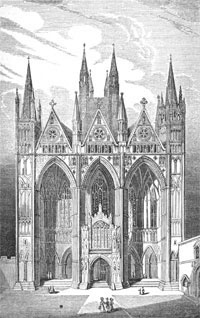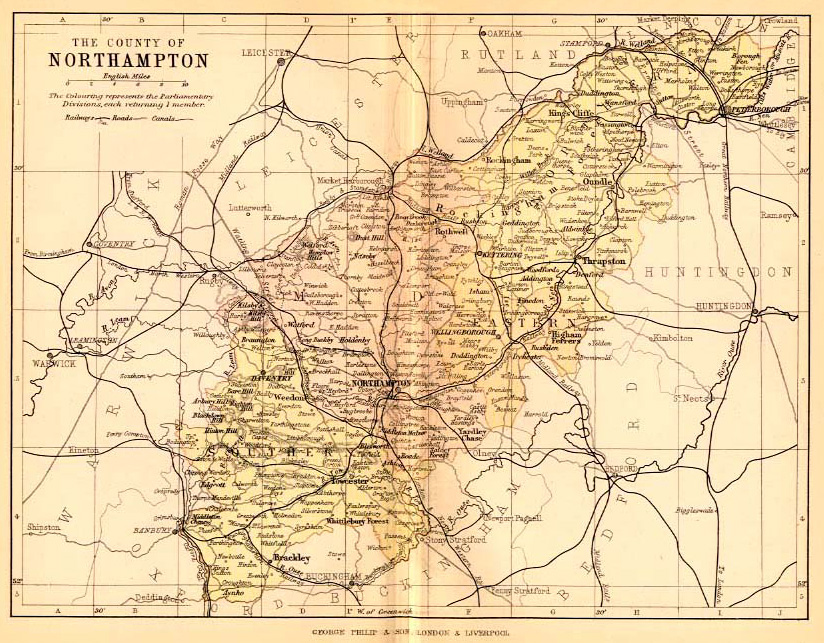 150 million years ago in the Jurassic era the area that Eye now covers was a warm subtropical ocean. The clay underlying the area that was so important to the villages brickworks contains the remains of sea creatures that swam in that ocean. The temperature was much warmer then and movement of the earth’s crust has slowly transported the floor of this ocean from its original position further south to its current latitude and elevation.
150 million years ago in the Jurassic era the area that Eye now covers was a warm subtropical ocean. The clay underlying the area that was so important to the villages brickworks contains the remains of sea creatures that swam in that ocean. The temperature was much warmer then and movement of the earth’s crust has slowly transported the floor of this ocean from its original position further south to its current latitude and elevation.
More recently, towards the end of the last glacial period, 10 thousand years ago, huge quantities of gravel and sand were deposited on top of the Jurassic clays by the enormous amount of water from the melting ice caps. Between 15 to 10 thousand years ago animals roamed the land near to the receding ice sheets. Woolly Mammoth, Woolly Rhino, Hippopotamus, Horse, Reindeer, Bison, Wild Oxen and Bear have all left their bones to be found in the gravel beds. As the ice caps melted, the sea levels rose and the land was partially flooded. This marshy fenland lasted for thousands of years until it was drained in the 17th century.
There is evidence that people have been in the area surrounding Eye for thousands of years. A Neolithic axe hammer, 4000 – 2000 BC and many other artefacts have been found to the south of the village and at nearby Flag Fen, there is evidence people have been in the area since 2000 BC. It was probably just seasonal visitors at first the area would have been rich in many food types like eels and wildfowl.
Flag Fen featured in an episode of the Channel 4 show Time Team. I was very lucky to visit the site while filming was taking place. The Channel 4 show ran from 1994 to 2014. It was presented by Tony Robinson (Sir Anthony Robinson), it featured a team of specialists carrying out an archaeological dig over a period of three days. The show visited the area on numerous occasions. Northborough, Norman Cross and Castor were all covered in separate shows. The show is still available online, is shown on the Yesterday TV channel and can find further episodes here. The show has been credited with promoting archaeology in the UK, it still remains an excellent educational resource.
Evidence for a roundhouse and pottery which dated back to Middle Iron Age (400-100 BC) was discovered on Crowland Road. There may also have been a paddock for animals and small-scale farming would probably have taken place. Just to the south of Eye is Tanholt farm and just to the south of that three barrows (ancient burial mounds) were discovered.
To the west of Eye runs Car Dyke, an 85-mile ditch built by the Romans in the second century AD. Although it is a common belief that this was a canal for transporting goods it’s more likely it was built for drainage to produce more fertile crops. The idea that it was a canal comes from William Stukeley who only lived in the 18th century and not from any historical documentation. The building of the dyke did provide a continuous inland water route from Cambridge to York and the evidence of population growth, and remains of forts discovered along the banks could provide evidence that it was used for more than just drainage. There’s more on the Dyke here. The Roman Empire collapsed in the 5th century AD and we entered the Middle Ages which lasted until the 15th centuries. It was during this time that Eye became part of the administrative area known as the Nassaborough Hundred, which later became the Soke of Peterborough.
 “Sent Athelwold was bidden by God’s lore
“Sent Athelwold was bidden by God’s lore
The Abbey of Brough again to restore.
Seynt Athelwold to King Edgar went
And prayed to help him in his intent.
Edgar bade Athelwold the work begin
And him to help ho would not lyn.”
The first mention Eye in any written form is from the Saxon Chronicles, specifically the Peterborough Chronicle which is also known as the Laud Manuscript, in the 10th century, AD 963. Bishop Athelwold came to Peterborough, which at that time was called Medhamsted, to rebuild the minster. The original monastery, which was started in AD 656 and took eight years to build had laid in ruins for ninety-six years after it was destroyed by the Vikings around AD 870. He ordered an Abbey to be re-built on the site of the old monastery. The Bishop showed King Edgar the Peaceful some writings that he found in the ruins of the old church of St. Peter and the King replied; “I Edgar grant and give to-day, before God and before Archbishop Dunstan, freedom to St. Peter’s minster at Medhamsted, from king and from bishop; and all the thorps that thereto lie; that is, Eastfield, and Dodthorp, and Eye, and Paston. And so I free it, that no bishop have any jurisdiction there, but the abbot of the minster alone. And so by royal decree, the Abbey and the land surrounding it including Eye would now be controlled by the Medhamstead minster and abbot of Medhamsted, who was Aldulf in 966. Aldulf became rich but left the minister to become Archbishop of York when the old Archbishop died in 972. Kenulf was chosen for the replacement abbot and the one who renamed Medhamsted, Peterborough. From this time until the Dissolution of the Monasteries under Henry VIII between 1536 and 1541 most of Eye belonged to the great Abbey of Peterborough, whose monks farmed here for centuries.
In 1125 there were said to be thirteen half-virgates and a couple of cow herds occupying the Manor of Eye, a small fen colony. A virgate was a unit of land area measurement used in medieval England and was held to be the amount of land that a team of two oxen could plough in a single annual season, about 30 acres. A ‘virgater’ would thus be a peasant who occupied or worked this area of land, and a ‘half more virgate’ would be a person who occupied or worked about 15 acres (6 Hectares).
By 1200 there was said to be 15 full virgaters and 12 men with small holdings and a cowherd, by 1300 there were a further nineteen new smallholders. Its also recorded that in 1300 that 255 acres of land were sown so the virgaters must have been reclaiming land from the surrounding marsh.
19th century onwards
The population for Eye in 1801 was 501. By 1851, only 50 years later, it had nearly tripled to 1,442. For the previous 1000 years life in Eye probably continued on much the same course but in 1866 the railway came to Eye. It’s hard now to imagine a train steaming along the outskirts of Eye but this became a reality when the Peterborough, Wisbech and Sutton Bridge Branch line opened to the North of the village. It was built to tap into the large fruit, flower and vegetable traffic of North Cambridgeshire and Norfolk. It stayed open nearly 100 years but was sadly closed in 1959, and although the closing is attributed to the Beeching Axe this was before that. See more about the line here. It would be interesting to see how different the development of Eye would have been if it hadn’t been closed.
Quarrying of Oxford Clay for brick making on an industrial scale in Eye began at the end of the 19th century and continued until the 1980s. Once dozens of brick kiln chimneys could be seen around Peterborough, now only the Whittlesey works remain. Sand and gravel are still quarried in Eye for the construction industry.
Until 1965 Eye was part of Northamptonshire as the county diocese is focused upon the cathedral in Peterborough. However, Peterborough had its own county council since 1888, and in 1965 was merged with the neighbouring small county of Huntingdonshire. Under the Local Government Act 1972 Eye, along with the city of Peterborough and Huntingdonshire, became a district of Cambridgeshire.

By the 1980’s the traffic in Eye had increased until the high street was a regular traffic jam at weekends. The A47 which crosses the country from Birmingham to Great Yarmouth carries a high volume of holiday traffic at weekends and commercial traffic during the week. It was becoming apparent that the need for a bypass was essential. Funding for a bypass was eventually put in place but the decision of whether the bypass should run around the north of the village and along the disused railway track or to the south of the village caused great debate at the time. The north route eventually won due to the land being ‘brownfield land‘ and a southern route would have meant traffic from the A1073 would have still have had to come through the village. Construction of the bypass was eventually started in 1990 and it opened in October 1991.
In April 2010 the local council held a consultation on plans to build 305 homes, 10 travellers’ pitches and a plot for travelling show people to be built in the village. Almost 300 people attended a meeting held in the Community Centre and 563 letters of objection were handed over to the council’s planning officers. Plans for the travellers and travelling show plots were eventually dropped, but the fight to stop or reduce the amount of housing goes on.
Thanks to £100,000 from the National Lottery in 2010 the grass field behind the Community Centre was converted to a Park with a woodland path, children’s adventure trail, a picnic area, drainage and new lighting and rides.
Links:
List of men who themselves or had relatives that lived in Eye and died in Great War www.warmemorial.firstworldwarrelics.co.uk
Places – Peterborough Museum
The impressively complete fossil skeletons of Jurassic sea monsters can be seen at Peterborough Museum and Art Gallery. The story of fenland drainage, brick making, and changes to the local environment is also told at the museum.
www.peterborough.gov.uk/leisure_and_culture/museum_and_galleries.aspx
References
*Peterborough Abbey, 1086-1310: a study of the land market by Edmond King
* Historical legends of Northamptonshire (1883)

In 1901 my great grandparents were living at Eastwood Cottage Eye. Does it still exist?
Sadly no, the land where it used to be located became part of Dogsthorpe Clay Pit. The pit has again been filled back in as its been used as a refuse tip. https://britainfromabove.org.uk/en/image/EAW018539 Then and now http://www.eyepeterborough.co.uk/wp/wp-content/uploads/2019/11/Eastwood-Farm.jpg
Am I right in thinking there was a butchers shop in Eye in about 1900 called James Sharpe, Have you any information on this, and did they have any connection to London. My Great Grandparents lived in Eye their surname was Norman. I think there may be a connection to James Sharpe.
Hi Pauline. My great great grandfather Matthew Norman (1851-1923) lived in Eye. I wonder if we are related.
My husbands relative John canwell lived in eye, he started off as a vermin catcher in 1861 and 1881 he was a cottager, I wonder if anyone knows anything about him .
My father was born at the toll bar, Eye. in 1911. He left the village when he was young and joined the army. We rarely visited Eye as my father settled in Derbyshire after he returned from Africa. Does anyone know where the toll bar was.
My 3 times Great grandfather was born in Eye in 1842, his name was Joseph Griffin. In 1881 he was a Butcher in Eye, living in Main Street.
If you could help me with more information on him and his family and their lives in Eye, that would be great.